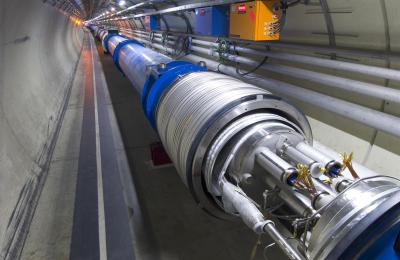Reigning in chaos in particle colliders yields big results

A method to correct tiny defects in the LHC's superconducting magnets (example shown above) was crucial to the discovery of the Higgs boson, which was announced in 2012. Credit: CERN
In a special focus issue of the journal Chaos, from AIP Publishing, a physicist at the European Organization for Nuclear Research (CERN) details an important method of detecting and correcting unwanted chaotic behavior in particle colliders. The method is helping accelerator physicists design high-performing, cost-efficient accelerators in an era of constrained science budgets.
The aim of the focus issue is to review, comprehensively, the theory and implementation of existing methods of chaos detection and predictability — as well as to report recent applications of these techniques to different scientific fields. The Focus Issue: Chaos Detection Methods and Predictability is collection of 12 papers representing the wide range of applications, spanning mathematics, physics, astronomy, particle accelerator physics, meteorology and medical research.
Chaos has long bedeviled physicists trying to describe the precise motions of interacting objects. The French mathematician Henri Poincaré discovered the essence of the phenomenon in the late 1800s when he attempted (unsuccessfully) to predict precisely the motions of the solar system's planets. The same chaotic behavior appears in the crowds of particles traveling inside accelerators like CERN's Large Hadron Collider.
In these machines, powerful electric and magnetic fields accelerate and guide beams containing trillions of particles. Ideally all particles would travel in orderly orbits around the rings into which they are injected. But in reality, some of the particles spread out around the ring's center, where they can become chaotic due to their mutual interactions and to defects in the magnetic fields that guide them. Particles that get kicked out of stable orbit can then crash into the collider's ultra-cold superconducting magnets. If this happens too often, the magnets heat up and the particle beams have to stop, which compromises experiments and creates costly delays.
From previous work in astronomy, Yannis Papaphilippou, a physicist at CERN, knew of a method called “frequency map analysis” that relates the frequencies at which objects oscillate to their chaotic behavior. Over the course of more than a decade, Papaphilippou and his colleagues applied the method to visualize those same frequencies in simulations of particle beams in accelerators. Using such simulations, physicists can design colliders to avoid chaotic beam interactions and keep particles on track.
The method has already born fruit. By modeling the extent to which tiny defects in the LHC's superconducting magnets cause protons traveling in the collider's rings to behave chaotically, Papaphilippou and his colleagues helped magnet builders design and produce these magnets within strict tolerance limits. The researchers also showed that only half as many correcting magnets were needed as was originally thought.
These findings substantially reduced the collider's cost and, along with many other efforts, helped streamline the search for the Higgs boson, Papaphilippou said. “All the big discoveries that we've had in the LHC…would have been hampered if there was not a very detailed design and evaluation of the nonlinear effects and their correction.” Frequency map analysis has also helped scientists optimize the Spallation Neutron Source in Oak Ridge, Tenn. As a result of this optimization, the machine set a world record last year for power delivery.
As physicists design new accelerators, Papaphilippou predicts they will use frequency map analysis to achieve high performance at reasonable cost. The Particle Physics Project Prioritization Panel (P5), which advises the U.S. government, identified collider cost as a major concern in a recent report on the future of particle physics.
“Studying these [chaotic] effects from scratch can be a very-cost effective way to build and design these accelerators,” Papaphilippou said.
The article, “Detecting chaos in particle accelerators through the frequency map analysis method,” is authored by Yannis Papaphilippou. It will appear in the journal Chaos on June 30, 2014. After that date, it will be available at: http://scitation.aip.org/content/aip/journal/chaos/24/2/10.1063/1.4884495
ABOUT THE JOURNAL
Chaos: An Interdisciplinary Journal of Nonlinear Science is devoted to increasing the understanding of nonlinear phenomena and describing the manifestations in a manner comprehensible to researchers from a broad spectrum of disciplines. See: http://chaos.aip.org/
Media Contact
All latest news from the category: Physics and Astronomy
This area deals with the fundamental laws and building blocks of nature and how they interact, the properties and the behavior of matter, and research into space and time and their structures.
innovations-report provides in-depth reports and articles on subjects such as astrophysics, laser technologies, nuclear, quantum, particle and solid-state physics, nanotechnologies, planetary research and findings (Mars, Venus) and developments related to the Hubble Telescope.
Newest articles

Superradiant atoms could push the boundaries of how precisely time can be measured
Superradiant atoms can help us measure time more precisely than ever. In a new study, researchers from the University of Copenhagen present a new method for measuring the time interval,…

Ion thermoelectric conversion devices for near room temperature
The electrode sheet of the thermoelectric device consists of ionic hydrogel, which is sandwiched between the electrodes to form, and the Prussian blue on the electrode undergoes a redox reaction…

Zap Energy achieves 37-million-degree temperatures in a compact device
New publication reports record electron temperatures for a small-scale, sheared-flow-stabilized Z-pinch fusion device. In the nine decades since humans first produced fusion reactions, only a few fusion technologies have demonstrated…





















